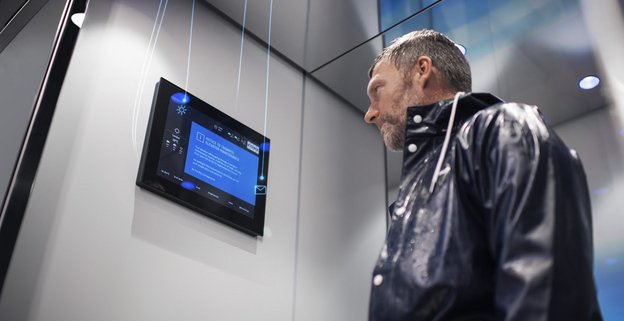Cities of the Future: What We Need To Build Safer Smart Buildings
By Michiel Bruggeman, Head of Innovation Asia Pacific at KONE

We live in a rapidly urbanizing world of cities characterized by busy spaces and stressed workers. Although they sound utopian, ideals of smart, connected buildings are within grasp.
To the people who will live and work in them, a smart building should be a simple interaction – but underpinning that effortless experience are layers of technology, from hardware deep underground to signals pinging through the Cloud.
To become truly accessible, healthy, sustainable, and running as efficiently as possible, components underpinning smart building development need to be connected by technology.
The foundations of a smart building
The underlying aspects of the smart buildings are mostly unseen. To enable these intelligent systems and encourage sustainable practices to address the current crisis of consumption that is driving global climate change, we need smarter materials and resource usage.
Circular systems are slowly starting to develop that better utilize waste products, returning them to functional use and reuse instead of simply discarding them. How can we eradicate waste in our cities? It starts with developing new materials at the core of our buildings. That could be materials that are easier to recycle at the end of life – think steel cables that require no oil such as KONE’s UltraRope™ – or integrating existing waste to reduce the amount of virgin resources needed to create materials, such as using plastic waste pellets to add more density to concrete, furniture or other components of a building.
Construction waste from the building or demolition remains an enormous problem in filling up landfill facilities; instead, we could start to integrate final building elements into the construction process. By using final lift shafts to move materials and workers, we reduce the amount of time in constructing a building, as well as the resources needed to build it.
With stronger systems underpinning a building’s physical structure, we can start to build layers that improve human interaction.
Establishing connectivity to enable interactions

Building on solid foundations of materials, we next need a mid-layer of connectivity that allows communication between different stakeholders and services. This establishes channels for the smart elements of a building to coordinate.
The physical elements of a building can enable a healthier space for people to flourish. Principles of sustainability, such as energy efficient buildings or use of regenerative technology, could reduce the need to rely on polluting elements. Regenerative technology either distributes or stores the energy exuded in an action, such as a lift storing up the energy created in a downward trip to power the journey upwards, or returning it to the building’s network. This better deploys limited resources in an effortless way that, while unnoticeable to the human eye, reduces consumption which will in turn cut emissions.
Better buildings aren’t enough in a fast-paced environment – as well as sustainable spaces we need interactive players. Robots could play an integral role in making buildings safer and healthier, by automating many tasks. Yet for robots to operate efficiently, they need to be able to ‘talk’ one another. One of the greatest hurdles our smart systems face isn’t the limits of innovation, but the very human problem of not speaking the same language. Initiatives such as Singapore’s Robotics Middleware Framework, that KONE has been heavily involved in creating, are building a blueprint for intra-robot relationships – reducing the need for time consuming service management and making it easier for robots to react to a dynamic and changing environment.
With an external layer that connects deeptech to human usability, we create space for more creative and collaborative interactions.
Predictive proactivity for seamless experiences
Building on established foundations that enable interactivity, reduce overconsumption and better allocate resources, the top-layer of any building must use intelligence to predict and prepare for what may happen next.
The technology embedded at every level enables a huge amount of data generation – data that can be used to inform decision-making and make predictions. This could include buildings setting up predictive maintenance, reducing the likelihood of accident or harm to people. It could also make for a more efficient physical building, with elevators being pre-deployed downstairs at peak-entry times, reducing the need for people to interact with previously high-touch areas (such as lift call buttons).
Better predictive integrations don’t just make the individual’s experience better or more seamless – they have significant accessibility upsides. By enabling users with additional access requirements the ability to navigate a building with more information, we are opening up spaces that were previously inaccessible without relying on human interaction or facilitation to manage the experience. In automating access to a building, people have more time and space to creatively consider ways they can further improve it; making them active and engaged participants in a healthy ecosystem.

Innovation is an opportunity for all
Instead of imagining a smart building as an amorphous collective of ideas, we can already see how it will fundamentally function. Technology enables change. It connects to various systems and services to optimize the customer experience, while learning preferences to improve for next time. In a future world of smart cities, user experience and the reliability of delivery will set a building apart in the market.
Building solutions should be an investment in the future. By rethinking materials at construction or design phase, we can make structures that are built to last, future-proof technological layers and create truly smart sustainable buildings. But a solitary building is not enough.
Collaboration and co-creation with government agencies and building owners will allow us to collectively pivot and transform the building industry. A spirit of collaboration between companies that are willing to be a part of an open innovation playing field will be the key to building smart nations around the world, establishing a path to a sustainable future for all.




